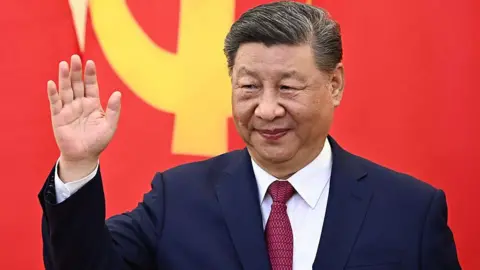In a significant diplomatic maneuver, China’s President Xi Jinping recently urged Vietnam to stand against “unilateral bullying” in a clear stance supportive of a global free trade system, without explicitly naming the United States. Such a call to action was delivered during Xi’s ongoing “charm offensive” trip across Southeast Asia, which includes stops in Malaysia and Cambodia. The trip, previously scheduled, has gained substantial relevance due to the increasingly charged climate of a trade war between the US and China, where implications on Vietnamese commerce and trade practices loom large.
This unfolding narrative comes as Vietnam faces substantial US tariffs, potentially reaching as high as 46%. The situation took a pivotal turn last week when the Trump administration announced a temporary pause on these tariffs for a 90-day period, raising questions about how countries in the region, particularly Vietnam, will navigate their roles in the face of a dominant US-China rivalry.
US President Donald Trump has been vocally critical of Xi’s outreach to Vietnam, characterizing it as a strategic ploy to undermine American interests. Trump insinuated that Xi’s meetings with Vietnamese leadership—including their Communist Party Secretary-General, To Lam—were primarily focused on ways to “screw the United States of America.” His criticism reflects the harsh rhetoric that has punctuated the trade relations between the top two global economies.
In a speech reported by the state-run media outlet Xinhua, Xi emphasized the need for Vietnam to collaborate with China to reinforce “strategic resolve” and bolster the stability of the global free trade framework. Xi’s remarks are regarded as a calculated response to the adversarial stance taken by the Trump administration, where political analysts like Stephen Olson view this as a tactical move to position China as the defender of a rules-based trade system. Meanwhile, America is portrayed as a nation acting recklessly in trade matters, contributing to the tensions that are shaping the current economic landscape.
The ongoing trade tussle escalated recently when the Trump administration imposed tariffs as high as 145% on a majority of Chinese imports, resulting in a reciprocal response from Beijing, which announced its own tariffs of up to 125% on American goods. This back-and-forth not only complicates the economic ties between the US and China but also places countries like Vietnam in a precarious position, torn between economic interests and international alliances.
While President Trump has expressed no direct blame towards either China or Vietnam in his conversations, he reiterated concerns about their collaborative efforts against U.S. interests. Alongside these interactions, a U.S. customs notification indicated that certain electronic devices including smartphones and computers would be exempt from the high tariffs, only for Trump to later refute this information, suggesting that such reports were misleading and that the items in question would merely transition into a different tariff category.
As Xi’s visit unfolded, he was warmly received in Hanoi, with hosts welcoming him with Vietnamese and Chinese flags. During this meeting, he conferred with top Vietnamese officials, including Prime Minister Pham Minh Chinh, before participating in a ceremonial wreath-laying at the Ho Chi Minh Mausoleum. This gesture acknowledged Vietnam’s historic leader and the Communist revolution that established the state.
Observations from experts like Susannah Patton, Director of the Southeast Asia Program at the Lowy Institute, reveal Vietnam’s cautious stance in managing international perceptions. While they recognize China’s significant economic role, especially as a competitor and partner, Vietnam is equally careful not to appear as colluding with China at the expense of its relationship with the US, underscoring the complexity of regional geopolitics in a time of heightened tensions.
Following his engagement in Vietnam, Xi is scheduled to continue his Southeast Asian tour with an arrival in Malaysia, where he will meet with the nation’s monarchy and political leaders. This trip signifies a concerted effort by China to strengthen ties within the region while framing the narrative around US trade policies as unreliable and protectionist, in contrast to China’s consistent partnership offerings. As highlighted by various analysts, the outcomes of such visits could present “golden opportunities” for Xi to reshape international relations in a way that favors Chinese influence while marginalizing American presence in Southeast Asia.



